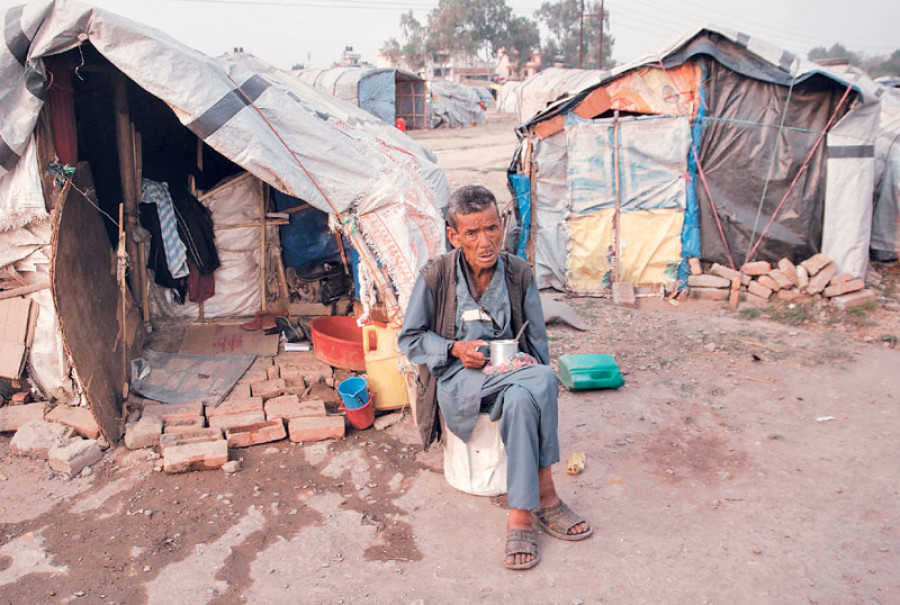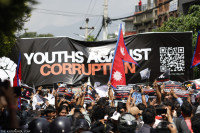Opinion
Survivors first
Living in makeshift tents for the past one year has been exasperating for the quake victims
Sarin Ghimire
Fulmaya Rai, 61, took a deep breath when asked about whether she knew it had been a year since the Gorkha earthquake ravaged the country. “Of course I do, but life goes on,” she muttered. Rai is among those still living in makeshift tents at an empty ground on the Taragaon premises in Chucchepati, Kathmandu. There are around 1,600 people in 450 tents.
At 10am on April 25 last year, Fulmaya had just brought back home her ailing 26-year-old son from the hospital, where he had stayed for almost six months for an operation that put his mother in Rs700,000 debt. As soon as she left for work, at around noon all hell broke loose when the ground beneath shuddered and heavy rumbling reverberated all around. Rai frantically gasped back to her rented apartment near the Boudha Stupa, only to see a semi-standing structure and houses piled up on top of one another. She could not recall the few following minutes for she fell to the ground unconscious. “At that moment, all I could think of was my son,” said a desolated Rai. Fortunately enough her son was taken out of the house in time by one of her neighbours, the same person who later carried an unconscious Rai to safety.
Rai and her son have been living in a tent in Chucchepati ever since. She scrapes through two square meals a day as a construction worker, while her son ekes out a living as a ‘khalasi’ (bus conductor) but hardly returns home. Originally from Sankhuwasabha, Rai moved to Kathmandu three decades ago. She has not returned home since, and is yet to collect the Rs10,000 the government initially offered as immediate relief. “Neither do I have the money nor the zeal to go to Sankhuwasabha to collect the money,” Rai said. An uneducated elderly citizen, she does not have anyone to rely on back home; nor does she believe that the ‘rajya’ would ‘without any hassle’ hand her the money. And since Rai’s house in Sankhuwasabha was under the name of her husband who has gone missing since the past 15 years, she is unlikely to receive the Rs200,000 that the government will hand out for reconstruction.
Political bickering
For survivors like Rai, the word ‘state’ is anonymous. Following the earthquake, the resilience shown by the security forces and the people themselves, both survivors and community workers, were widely commended despite the fact that the government was underprepared for such massive natural calamities. The then government went ahead with conducting a Post Disaster Needs Assessment and Rapid Environmental Assessment to calculate the total losses and the future course, which in due turn made it easier to convince the donor community in pledging aid during the International Conference on Nepal’s Reconstruction held last year. However, since then the whole idea of providing succour to the survivors has been mangled by political wrangling all the way from the top to the bottom.
Questions may have arisen with the appointment of Govind Pokhrel as the CEO of the much anticipated National Reconstruction Authority for he was already serving as the vice chairman of the National Planning Commission, but it was the CPN-UML’s (a major coalition then) decision to withdraw its support on forming the authority, which was the first real indication that the survivors were in for a long wait. Eventually the UML had its own prime minister and appointed a rather less experienced person in handling state affairs and one of its own cadres into the glorified post exactly ten months later.
On the ground, whether one deserves the money handed by the government or a blanket at the peak of winter cold depends on the person’s political connections. The case was similar for Fulmaya. ‘Political cadres’ in the name of providing her with an earthquake victim card ripped Rs600 off her. All three times she had no option but to fall for their promises since she never witnessed the state providing anything to her but always hoped that she would not miss out if such opportunity knocks. When relief goods arrived at Chucchepati, it was always the so-called politically affiliated people who took charge. And by the time she arrived from work in the evening, the goods were already distributed to the ‘near’ ones.
Living in the makeshifts for the past one year has been exasperating for the quake survivors. During the monsoon, an unmanaged drainage system flooded their tents almost knee high, and in winters their bones froze to death. Unemployment has led to some binging on local alcohol and some have resorted to theft. Frustration has brewed communal disharmony among survivors. “Especially for single mothers like us who have no one to look after, we fear for the safety of our belongings, and more so ourselves,” sighed Rai.
Better late
It was only this month that the government started handing over the reconstruction money, beginning from Dolakha. The Central Bureau of Statistics (CBS) is yet to complete its detailed damage assessment in most parts of the affected districts, which will then allow victims to receive the money for reconstruction. But for Kathmandu, despite the prime minister pledging on the national television that the survey will be completed within a month, the CBS is yet to begin work. In reality, the meager amount the government will be providing will not be enough to rebuild houses in the Capital. Moreover, most of the people have neither the skills nor the time to build a new home themselves. At a time when unemployment and inflation are high, scarcity of essential goods prevails, house rent and living costs have skyrocketed, and the government is being a mere bystander, these victims still cannot look beyond survival. It is still about a roof on the head—be it plastic or wood—and bread on the table.
If the Reconstruction Authority and the government have some sort of humanitarianism left in them, let us make some wishful thinking that these survivors will not have to spend another winter out in the open.
Ghimire is a sub-editor with The Kathmandu Post




 8.12°C Kathmandu
8.12°C Kathmandu










